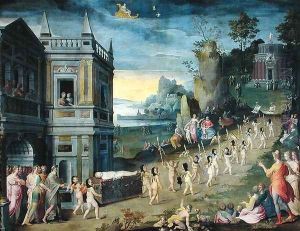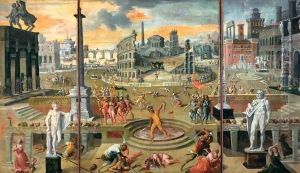Studio of Caron, Antoine (1520-99) Paintings
Antoine Caron was a French master glassmaker, illustrator, Northern Mannerist painter and a product of the School of Fontainebleau. Born in 1520 in Beauvais, Oise, Caron is best known for his distinctive style, characterized by elegant figures and complex iconography, which often reflected the tumultuous political and religious climate of late 16th century France.
Caron's early life and training are not well-documented, but it is believed that he started his career as a glass painter, which was a common practice for artists before they transitioned to painting on canvas or panel. His work as a glass painter had a significant influence on his later painting style, particularly his sense of color and light.
In the 1550s, Caron was involved with the School of Fontainebleau, where he was influenced by Italian artists who introduced the Italian Mannerist style to France. This influence is evident in his later works, which combine the elegance and grace of the Italian Renaissance with a distinctly French sensibility.
Caron became the official court painter to Catherine de' Medici, queen consort of King Henry II of France, and later served her sons, Kings Francis II, Charles IX, and Henry III. He was deeply involved in the design of court pageants and festivals, which gave him the opportunity to display his talent for grand and imaginative compositions. His paintings often included allegorical and mythological themes, as well as contemporary events, particularly the French Wars of Religion.
One of his most famous works is the 'Massacres under the Triumvirate' (1566), which depicts the horrors of the conflict between Catholics and Protestants in graphic detail. This and other works by Caron are considered important historical documents as well as artistic masterpieces, providing insight into the era's events and the court's taste for the dramatic and allegorical.
Caron's contribution to the arts extended beyond painting. His designs for the lavish court entertainments of Catherine de' Medici were innovative and influential, contributing to the development of the ballet de cour, an early form of ballet that blended dance, music, and spectacle.
Caron's works can be found in several major museums across the world, including the Louvre in Paris and the Metropolitan Museum of Art in New York. His legacy is that of a master artist who captured the spirit of his time with elegance and narrative depth. Caron continued to be active until his death in 1599, leaving behind a body of work that continues to be studied and admired for its historical significance and artistic beauty.

